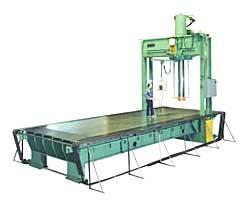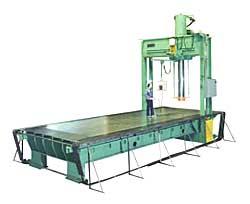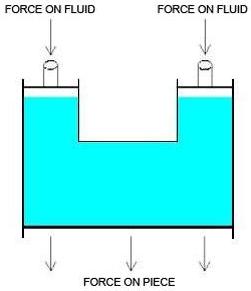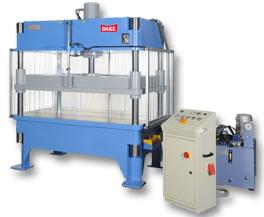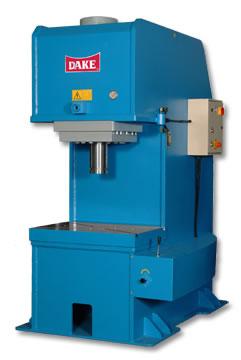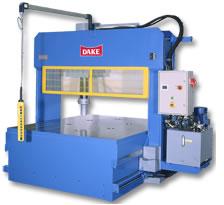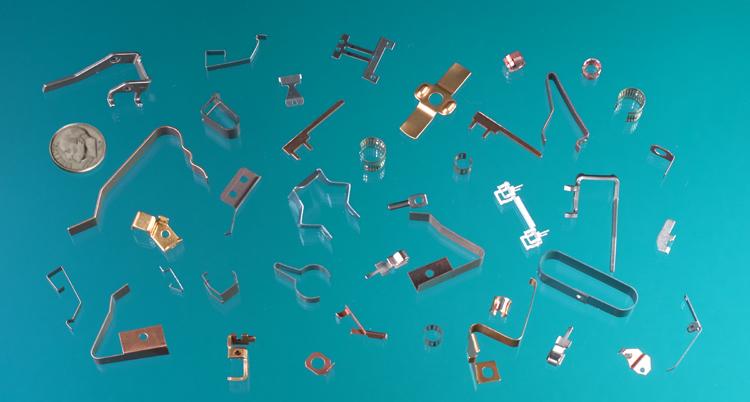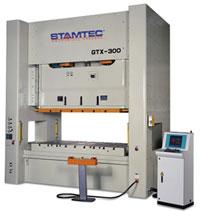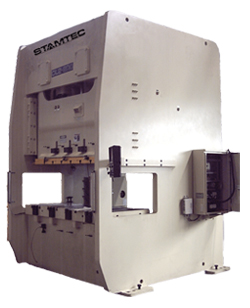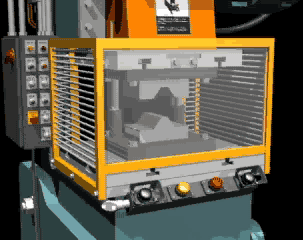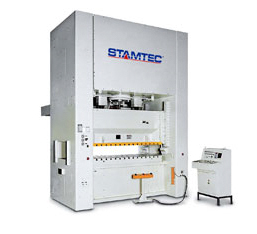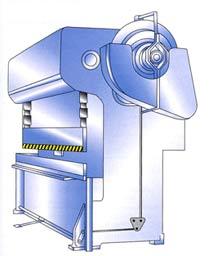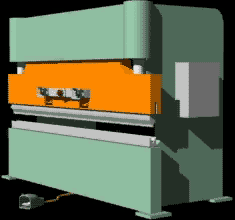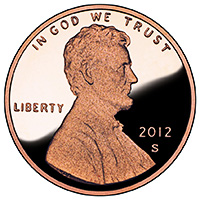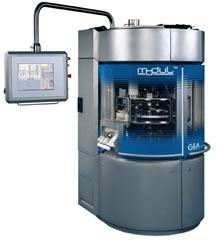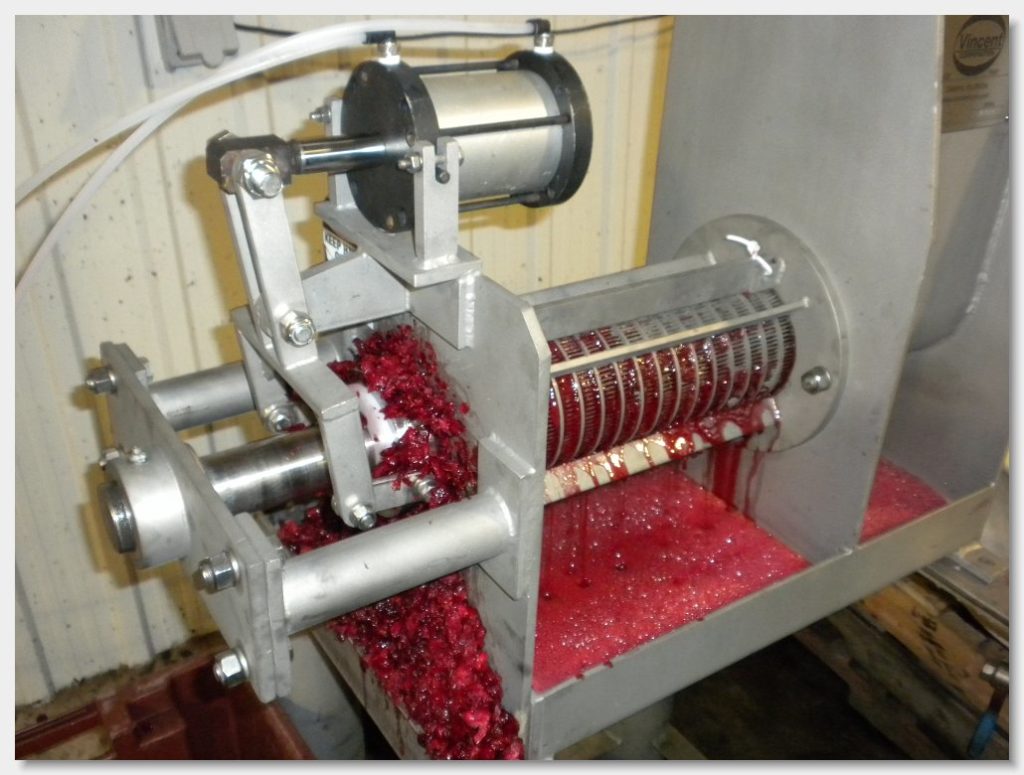Presses are used to apply pressure to an object in many engineering applications. They are commonly used for making glass, metal forming, dewatering sludges, and powder compacting. The two major types of presses are hydraulic and mechanical. The following sections on types of presses covers general information, equipment design, usage examples, and advantages/disadvantages.
Hydraulic Presses
Hydraulic presses use pressure transferred through a fluid to apply a force. Applications include metal forming and dry ice making.
General Information
In a hydraulic press, a small force applied to a small area creates a large force over a large area, as shown in the diagram.
Hydraulic presses work by using Pascal’s principle. The mechanical advantage of a hydraulic press is determined by the ratio of the large area to the small area.
Equipment Design
The main components of hydraulic presses, shown in the animation, are:
- Bed: Surface that the piece being worked on rests
- Mold: Object into which the piece is compacted; gives the piece its shape
- Platen: Place where the mold attaches, can be heated for special applications
- Cylinder Assembly: includes the hydraulic cylinder, piston, ram, and seals
- Pump: used to pump fluid into the hydraulic cylinder
There are numerous designs for hydraulic presses. These include two- and four-post presses, where the number refers to the number of stationary tie rods guiding the motion of the platen. The four-post presses can support more tonnage, for example, the four-post press shown below can support up to 200 tons.
There are also different designs for the frames, such as C-frame and H-frame, or straight side, presses. C-frame presses, pictured below to the left, can be accessed from three sides and take up less floor space than straight side presses, while straight side presses have a greater tonnage capacity and prevent angular deflection of the platen. The picture below to the right is an example of an H-frame press with a movable frame.
(Copyright Dake Corp., Grand Haven, MI)
Presses can be designed so that the force is not always acting downwards, to meet the needs of specific applications. Horizontal draw presses can be used to punch out brass cups out of sheet stock. A hydraulic ram pushes the cups through a die and then draws the cups into elongated tubes. Tilting presses are used for injection molding to aid in the material flow in the mold. In injection molding, the molding material is heat-softened, injected into a mold, then cooled to form the desired product (see the Injection Molding section of the encyclopedia for more details).
Usage Examples
Hydraulic presses can be used for applications such as injection molding, dry ice pressing, powder compacting, metal forming, and dewatering mixtures. In injection molding, the molding material is heat-softened, injected into a mold, then cooled to form the desired product. This image shows some examples of products created by metal forming.
Powder compacting is a major chemical engineering application for hydraulic presses. Powder compacting presses are used to create ceramics, engine parts, magnets, and light bulb filaments. The presses can also be operated in a hot or cold environment, depending on the material being pressed.
The image below shows the stages of a powder compacting press. The orange mold is filled, shuttled into the press, compacted, then the pressed material is ejected.
Advantages
- The full force of a hydraulic press can be applied over the entire range of motion, unlike mechanical presses that only reach maximum power at the bottom of the stroke.
- The force applied over the pressing stroke is controllable.
- Smaller and cheaper than mechanical presses.
- More platens (decks) can be added for multi-product work.
- A curtain of light, such as a laser, can be used to stop the ram for safety.
Disadvantages
- Hydraulic fluid can cause corrosion if the piston is not properly coated.
- Generally slower than mechanical presses due to fluid pumping.
Mechanical Presses
Mechanical presses are powered by a motor and flywheel and perform most of the same tasks as hydraulic presses.
General Information
A mechanical press is any machine that exerts pressure without using hydraulics to form, shape, or cut materials, extract liquids, or compress solids. Mechanical presses have slowly been replaced by hydraulic presses because they are less safe and less precise. The 2-point straightside mechanical press shown below is used to quickly stamp relatively long, narrow parts.
Equipment Design
Mechanical presses are generally powered by electric motors. The motor supplies energy to a flywheel, which releases energy to the ram through gears or a crankshaft.
The main components of mechanical presses are:
- Ram: Moves up and down to create pressure
- Point: Connects the ram to the driving mechanism
- Die: Holds the piece being worked on and gives shape for reformation
- Flywheel: Rotates and provides power to the ram
- Brake: Stops the press when the clutch is disengaged
Typical mechanical presses include 1,2 point C-frame presses and 1,2,4 point straightside presses. A 2-point straightside press used for stamping large parts that require a large bed area is pictured below. These types of presses are very accurate, controlled by eight full-length ninety-degree gibs.
Mechanical presses can be single, double, or triple acting, depending on the number of rams. Double acting presses have a subdivided ram such that one portion holds the piece while the other forms it.
An air-friction clutch can be added to make high speeds more efficient. This clutch provides a cushioning effect by slowing down the ram near the bottom of the stroke, thus, extending the die life.
The clutch in a mechanical press can be either full- or partial-revolution. A full-revolution clutch cannot be disengaged until the press has completed one full stroke, while a partial-revolution clutch can be disengaged at any point during the stroke. Press brakes are often used to form sheet metal.
(Copyright the United States Government, Occupational Safety and Health Administration)
Usage Examples
Mechanical presses are used for sheet metal blanking, piercing, forming, drawing, and glassmaking. To create the intricate embossed designs on the coins below, a punch press forces two plates together which deform blank pieces of metal.
Hot and cold forging methods can also be used. Hot forging presses heat metal close to its melting point to shape hard-to-forge alloys. Cold forging presses are used for applications requiring high tonnage at the bottom of the stroke, such as coining, bending, or punching.
Advantages
- Pressed parts are stronger than machined parts due to a change in the internal structure of the material.
- More energy efficient than hydraulic presses.
- Faster than hydraulic presses.
- More platens (decks) can be added for multi-product work.
Disadvantages
- Less controllable and less precise than hydraulic presses.
- More dangerous than hydraulic presses because of high speed and fewer stopping mechanisms.
Tablet Presses
General Information
The tablet press is used to compress granules into their final form as tablets.
Equipment Design
A tablet press station refers to a die and its associated punch. A press may have more than one punch at a station at opposite sides of the die to provide a greater and homogeneous pressure. In small-scale operations, an eccentric press with a single station is used, while large-scale operations use a rotary press with multiple stations. In an eccentric press, the compression force is generated by hand or by a piston. In a rotary press, a roller passes both punches, causing them to compress at the same time. For both eccentric and rotary presses multiple die and punch sets can be used to achieve a certain size or property of the tablets.
(Copyright GEA Process Engineering Inc., Columbia, MD)
Usage Examples
Tablet presses are commonly used in the pharmaceutical and nutraceutical industries to produce simple medications. They are also used in the production of food and consumer production.
Advantages
- Eccentric presses are small and easy to operate.
- Can control tablet characteristics.
- Operates without high maintenance.
- Operation is enclosed.
Disadvantages
- Rotary presses can be noisy.
Screw Presses
General Information
A screw press is used for pressing applications that involve liquid-solid separation.
Equipment Design
A screw press is a conical or cylindrical device housing an internal rotating screw. Solid feed material is added at the top of a vertical device or on either end of a horizontal device, as shown below. The rotating screw drives feed through the device. As the feed moves, it is compressed by the screw in the taper. The compression causes liquid to be expressed from the feed material. Screw presses can be equipped with screens or slatted walls to allow liquid to flow out of the device.
Usage Examples
Screw presses are used in liquid-solid separations and dewatering applications, such as fruit juicing, fish and chicken meal production, and tea leaf production. The image above shows a screw press expressing cranberry juice. Screw presses are also used to dewater sludge in wastewater treatment operations. This is important in the wastewater treatment application as it can reduce the amount of sludge produced, effectively minimizing odors stemming from the plant’s operation – This is increasingly important in urbanized areas.
Advantages
- Can be used as a continuous process
- Can reduce sludge production in the dewatering process
Disadvantages
- Extensive use of press aids required for efficient operation (fruit juice application)
Acknowledgements
- Dake Corp., Grand Haven, MI
- Gambit Corp. , Rohnert Park, CA
- GEA Process Engineering Inc., Columbia, MD
- Savage Engineering, Inc., Garfield Heights, OH
- Stamtec, Inc., Manchester, TN
- United States Government, Occupational Safety and Health Administration
- Vincent Corporation, Tampa, FL
References
- AIDA-Europe. “High Speed Presses Match Automotive Needs.” Manufacturing Talk. Aug 7, 2003.
- Ashurst, Phillip R. “Fruit Juices.” Kirk-Othmer Encyclopedia of Chemical Technology (2007): Wiley Online Library. Web.
- Baker, Alan K. Industrial Brake and Clutch Design. London: Pentech Press, 1992. Print.
- Bennett, Bill and Cole, Graham. Pharmaceutical Production: An Engineering Guide. United Kingdom: The Institution of Chemical Engineers, 2002. Print.
- FKC Screw Press.” FKC Co. Ltd. Web. 18 Sept. 2017. <http://www.fkcscrewpress.com/index. html>.
- “How to Buy a Press Brake.” Metal Working Machinery Mailer. Jun 1, 2000.
- Haupert, Laura. “Odor Issues and Solutions for Wastewater Treatment.” Chemical Engineering. September 2017: 39. Print.
- Kolisch, G; Boehler, M; Siegrist, H; Krauss, W. “Use of a Hydraulic Press System for Dewatering Municipal Digested Sludges.” KA – Wasserwirtschaft, Abwasser, Abfall [KA Wasserwirt. Abwasser Abfall]. Vol. 52, no. 8, pp. 908-913. Aug 2005. Aqualine. Accessed: Feb, 10, 2006.
- Lewis, Richard J., Sr. Hawley’s Condensed Chemical Dictionary. 14th ed. John Wiley & Sons, 2002. Print.
- Phelan, Richard M. “Hydraulic Press,” in AccessScience@McGraw-Hill, http://www.accessscience.com.proxy.lib.umich.edu, DOI 10.1036/1097-8542.327000, last modified: May 13, 2002. Accessed: Feb 10, 2006.
- Saraswathi, B. “Tablet Press.” Pharmainfo. Pharmainfo. Web. Pharmainfo.net
Developers
- Dave Carpenter
- Keith Minbiole
- Henry Chen
- Thomas Plegue
- Nathan Hoffman
- Emma TerBeek

